North and South Korea had their first musical exchange some 30 years ago, and popular music in particular entered the scene around 20 years ago. For the two Koreas with different ideologies and political systems, an encounter through music means more than just cultural exchange; it is an effort to restore their identity as one nation by promoting reconciliation and peace.
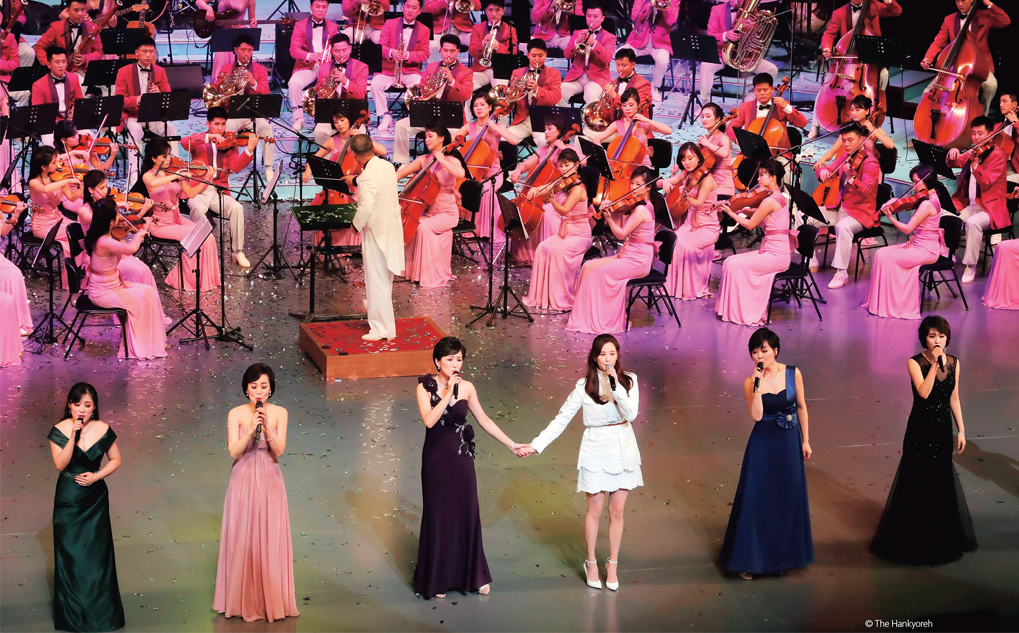
At the Samjiyon Orchestra concert held on February 11, 2018, at the National Theater of Korea in Seoul, Seohyun (fourth from left) from Girls’ Generation sings with North Korean performers. Part of the North’s official delegation to the PyeongChang Winter Olympics, the band gave another concert in Gangneung, the host of the indoor events, on February 8.
On February 8, 2018, the day before the opening ceremony of the PyeongChang Winter Olympics, stormy sea winds calmed down in Gangneung, a city on the east coast hosting the indoor Olympic events, and in the afternoon, the temperature rose to 6 degrees Celsius. That day, a concert by the Samjiyon Orchestra, part of the North Korean delegation that had come to celebrate the Winter Olympics, was scheduled at the Gangneung Arts Center. The ensemble of over 140 members was newly organized to bring together the greatest instrumentalists, singers and dancers from the existing Samjiyon Band, Moranbong Band and State Symphony Orchestra.
Though the weather had grown milder, the people gathered for the show could not relax until the curtain eventually went up. Just a few months earlier, war had seemed imminent on the Korean peninsula. Some South Korean media outlets nicknamed the orchestra’s leader Hyon Song-wol “the nuke girl” in parody of the famed North Korean revolutionary opera, “The Flower Girl,” predicting that the concert would prove to be yet another piece of propaganda.
However, the tension that filled the hall eased as soon as the concert began with the song “Nice to Meet You.” The audience greeted the heartfelt performance, featuring songs appealing to universal emotions rather than political ideologies, with enthusiastic applause.
A Deluge of Southern Songs
The first North Korean musical ensemble to perform in the South in 16 years had made thorough preparations. The most notable part was the audio mixing, carried out by two sound engineers who had brought along their own mixing consoles. The smooth mixing and fine balance between the vocals and instruments impressed the South Korean staff recording the show for TV. The lighting was excellent, too. The spotlights pinpointed the major ps with such precision that at times, it almost looked unnatural. The troupe’s uniforms and hairstyles were a bit outdated, reflecting the collectivism of the North stressing unity and conformity. However, for almost two hours, the instrumentalists rarely glanced at their scores while playing numerous tunes, ranging from classical to popular music, again demonstrating their diligent preparation.
The orchestra played 13 South Korean songs. Two of them were protest songs well known in the North as well, while the remaining 11 popular songs were free of any political message. The songs frequently mentioned the words “love,” “tears” and “farewell.” In other words, they carried “the yellow wind of capitalism,” often denounced by the North Korean authorities. Then why bear the burden of performing those prohibited songs? By catering to the sensibilities and tastes of the South Korean audience, the musicians were obviously trying to promote a better understanding of different lives and thoughts and pull down the emotional wall between the two sides.
Moreover, the repertoire reflected the influence of South Korean artists who had performed in the North - intermittently since 1999. Some of the songs presented this time had been performed before in Pyongyang: “Farewell” by Patti Kim in 1999; “The Maze of Love” by Choi Jin-hee in 1999 and 2002; and “To J” by Lee Sun-hee in 2003.
Catalyst of Exchange
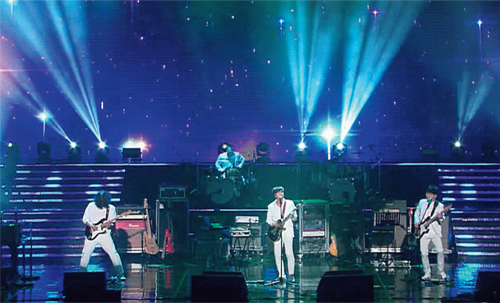
The Yoon Do-hyun Band performs at the North-South joint concert “We Are One,” held April 3, 2018, at the Ryugyong Chung Ju-yung Gymnasium in Pyongyang. The band had also participated in the 2002 concert “Oh! Reunified Korea” organized by MBC at the East Pyongyang Grand Theatre.
Musical exchanges between the two Koreas date back to 1985, when they agreed to hold concerts in each other’s capital in September of that year to coincide with the first-ever reunions of families separated by the Korean War. Each side sent a delegation of 50 artists, but their performances were not received well on either side: the South Korean concert, mostly presenting traditional court music and dance, was deemed “feudalistic and decadent” by North Koreans, whose concert in turn was considered “rigidly uniform and undermining tradition” in the South.
A few more events followed, alternately held in Pyongyang and Seoul, barely keeping the exchange going. It was not until 1999 that pop concerts were held in front of large audiences. On December 5 that year, the Seoul Broadcasting System (SBS) held the “Peace and Friendship Concert 2000” at the Ponghwa Art Theatre in Pyongyang.
It was a joint performance with Roger Clinton, the brother of then U.S. President Bill Clinton.
Later, on December 22, the Munhwa Broadcasting Corporation (MBC) held the “National Unification Concert” at the same venue. The SBS concert, the first cultural event in the North organized by a South Korean broadcaster, was held amid a mood of détente under the “Sunshine Policy” of the administration of late South Korean President Kim Dae-jung. Featuring first-generation K-pop groups, including Sechs Kies and Fin.K.L., the concert shed light on socio-cultural differences by showcasing South Korean pop culture trends. In contrast, the MBC concert appealed to the cultural homogeneity of the two Koreas by presenting traditional folk songs and popular songs from the colonial period, as well as popular contemporary numbers.
Cross-border cultural exchanges have continued in spite of difficulties, mainly through popular music concerts, with South Korean artists visiting the North more frequently than vice versa.
In 2002, MBC held events titled “Lee Mi-ja: A Special Concert” on September 27 and “Oh! Reunified Korea” the next day, both at the East Pyongyang Grand Theatre. At the latter event, rock singer Yoon Do-hyun and his band stunned the North Korean audience by singing the timeless folk song “Arirang” in a shockingly free style.
On August 11, 2003, the Korea Broadcasting System (KBS) presented the “Pyongyang Singing Contest” in Moranbong Park. The long-standing South Korean music show, launched in 1972, makes it a rule to put the name of each location at the end of its title - e.g. “National Singing Contest in Pyongyang” - but agreed to change the title in compliance with the North’s claim that “the name Pyongyang, the heartland of the revolution, should not come at the end.” At the show, some 20 contestants, ranging from 12 to 77 years of age, demonstrated their singing abilities.
In October 2003, SBS held the “Unification Concert Celebrating the Opening of Ryugyong Chung Ju-yung Gymnasium.” To celebrate the inauguration of the indoor sporting arena, built jointly by the Hyundai Group and the North Korean government, a group of 1,100 South Koreans, including performers and observers, crossed the armistice line to visit Pyongyang. The concert was the first musical event ever staged at a gymnasium in the North. At the same venue, SBS hosted a concert by famous South Korean singer Cho Yong-pil in August 2005. Though planned at the North’s request, the concert could only be staged a year later after being postponed seven times amid turbulent political circumstances, triggered by the South Korean government’s refusal to allow its citizens to visit the North on the 10th anniversary of Kim Il-sung’s death.
Cross-border cultural exchanges have continued in spite of difficulties, mainly through popular music concerts, with South Korean artists visiting the North more frequently than vice versa. Looking back, the trajectory has mostly been characterized by concerts in the North, hosted by the South’s broadcasting companies. This is due to several factors, such as the North’s internal conditions making it difficult for its artists to visit the South; the virtue of popular music creating emotional empathy more easily than other performing arts genres; and the relative advantage of broadcasting companies in organizing concerts on a grand scale, which require a large cadre of skilled staff and enormous funds.
Emergence of the Moranbong Band
Cultural exchanges between the two Koreas with their different political systems have had notable influences on both societies. The latest concert by the Samjiyon Orchestra has seemingly gone some way to mitigating the North’s belligerent image and raising awareness of peace and unity among the public in the South. However, it is not easy to estimate the repercussions the other way around as the North’s media are typically reticent about Southern visitors and their activities. Nothing can be surmised from audience responses either, since North Korean people cannot show an obvious liking for South Korean pop songs.
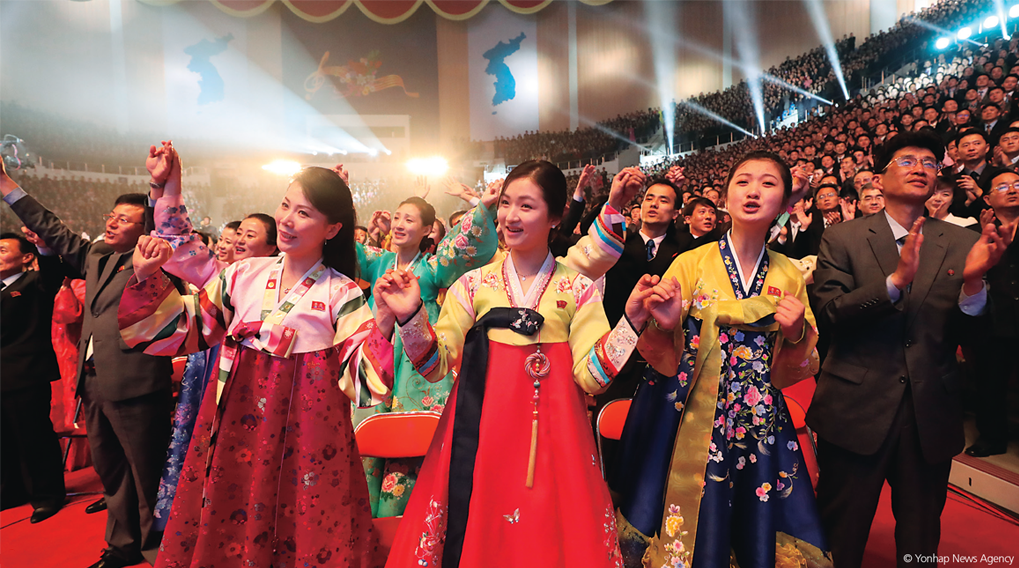
Pyongyang citizens sing and cheer at the “Peace Concert of South Korea’s Artistic Delegation in Hopes of Reconciliation and Cooperation: Spring is Around the Corner,” held April 1, 2018, at the East Pyongyang Grand Theatre.
Indirectly, however, some outcomes have become apparent in performances of the North Korean girl group Moranbong Band that was assembled in early 2012 under the direction of Kim Jong-un, chairman of the North’s State Affairs Commission. Composed of about 20 female singers and instrumentalists, the band has become a focus of national and international interest for their stylish outfits and unrestrained dance moves, as well as their gorgeous looks. The band seems to show the North’s willingness to change and brighten its image at home and abroad. Notably, they usually perform in large gymnasiums. North Korea once had the fixed idea that arts and culture events should take place in a theater and sporting events in a gymnasium, and its officials had vehemently opposed the idea of the South presenting pop music shows in a gymnasium in Pyongyang. However, after witnessing the success of concerts in gymnasiums, they began to follow suit, and the Moranbong Band now holds most of its concerts in gymnasiums that can accommodate large audiences and diverse stage designs.
It is also worth noting that the band started using jibs, or camera cranes, that are commonly used to film large-scale stage performances or sports events. A jib was first introduced during the Ryugyong Chung Ju-yung Gymnasium concert in 2003, when a South Korean broadcasting company presented it to the North. Ever since, jibs have played a central role in filming cultural events in the North, and as another outcome of exchanges with the South, stage flames and paper confetti were adopted tospecial effects.
After the Samjiyon Orchestra’s concert in Gangneung, a group of the South’s artists paid a return visit to Pyongyang in April. A historic event coming 13 years after Cho Yong-pil’s 2005 concert, it was entitled “Peace Concert of South Korea’s Artistic Delegation in Hopes of Reconciliation and Cooperation,” with the subtitle “Spring is Around the Corner.”
Since the division of the peninsula, the two Koreas have waged a relentless arms race to consolidate their respective systems. Thus, peace remains remote and the economic burden has grown ever heavier. Recently, voices have grown louder to cease the endless competition and instead pursue mutual prosperity through understanding and cooperation. Arts and cultural exchanges are undoubtedly very effective to promote amity and goodwill. Although a few concerts cannot tear down decades-old walls of distrust and enmity, over time continued efforts will surely bring the spring of reconciliation closer.
K-Pop Lands in North Korea
BTS, also known as Bangtan Boys, topped the Billboard 200 chart in June this year with their third album “Love Yourself: Tear.” It was the first time in 12 years that a non-English album took the number one spot on Billboard’s main album chart. As K-pop spreads around the world, it is also eliciting responses from the closed society of North Korea.
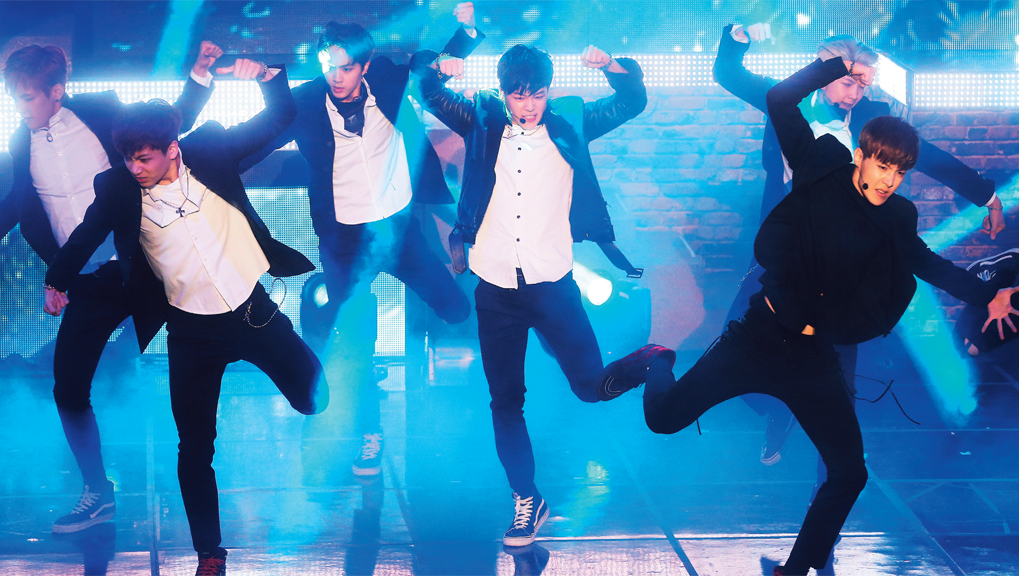
BTS (Bangtan Boys), who topped the Billboard 200 chart last June with their third full-length album “Love Yourself: Tear,” are known to be popular among young North Koreans.
After North Korean soldier Oh Chong-song defected last year by crossing the border in Panmunjom, suffering five gunshot wounds in the process, he amazed everyone by saying that he liked the South Korean idol group Girls’ Generation. Subsequently, when the New York Times released an article in spring this year, covering concerts by South Korean musicians in Pyongyang and focusing on the girl group Red Velvet, the headline read: “Can North Korea Handle a K-Pop Invasion?”
The North Korean government cracks down on the circulation and viewing of videos from the South for fear that its people might be “corrupted by decadent capitalist fads.” Nevertheless, South Korean videos are now popular merchandise in the North and widely disseminated in spite of government bans. Not only music videos but also movie soundtracks and TV dramas are circulated clandestinely.
South Korean pop hits are allegedly enjoyed almost simultaneously in the North as large quantities of DVDs and USB drives containing K-pop content are smuggled into the country from China. For example, when Psy’s “Gangnam Style” swept through the world in 2012, it quickly became popular in North Korea, too.
Control vs. Dissemination
USB drives, called “stick-type memory card” in the North, are widely used for playing South Korean films and songs. Memory sticks and SD cards are much sought after as they are convenient to carry and easy to hide. These days, MP5 media devices for viewing high-resolution videos also make their way into the country through China. Since an MP5 p uses a micro SD card, even smaller than a USB drive, it has an increased storage capacity and is easier still to evade crackdowns.
The dissemination of MP5 ps has enabled North Korean youths to watch K-pop videos with greater ease. No longer confined to surreptitious listening, they can now closely observe the singers’ faces, gestures, fashion and hairstyles, experiencing a culture shock even more deeply.
Culture Shock
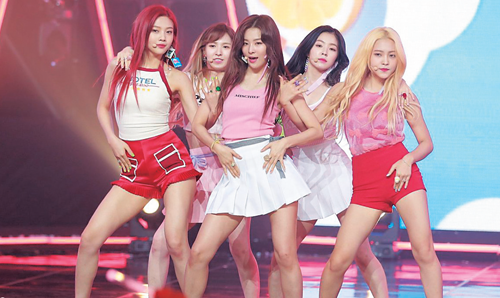
Invited to the Pyongyang concert last April, Red Velvet performed “Red Flavor” and “Bad Boy” for North Korean audiences.
North Korea has a long tradition of exploiting music to strengthen its system. Rallying for ideological warfare through music, it claims, “A single song can take the place of ten million troops.” Growing up in such a social milieu, young North Koreans fall for K-pop because the songs deal with universal human emotions - like Ahn Jae-wook’s “Friend,” known to be the most popular South Korean pop song in the North - rather than ideology and propaganda. Many defectors agree that North Korean songs are mostly political propaganda or glorification of its leaders while those of the South are honest s of human emotions.
The spread of K-pop in the North may partly be attributed to widening inter-generational gaps as well as deepening class division. In the North, youths are often called the “marketplace (changmadang) generation.”
The severe economic difficulties of the mid-to-late 1990s debilitated the country’s welfare system that provided free education, health care and rationed necessities, which the authorities had loudly promoted internally and externally. The “marketplace generation” refers to young people born around that time, who have barely experienced socialist welfare benefits. Compared to older generations, they tend to be more resistant to government controls.
For this new generation, K-pop may be a catalyst for passive nonconformity. While earlier generations, indoctrinated to possess the “spirit of human bullets and bombs,” are loyal to the government, group solidarity is weaker among young people. Undaunted by tightening restrictions and crackdowns on South Korean pop culture content, they boldly keep watching these videos because, among other reasons, singing along and dancing to K-pop gives one a bit of superiority over peers. Some even regard those who can sing and dance to the songs as “enlightened.”
The Marketplace Generation
Under these circumstances, the authorities are compelled to accept, at least to some extent, the cultural change and resistance among youths. Therefore, instead of relying on unconditional bans and controls, they have come up with a new genre of socialist music.
The North Korean government’s policy to satisfy the “higher standards of the people” indicates the intention to embrace the changing demands of its people by providing them with new creative works. A good example is the Moranbong Band, founded under Kim Jong-un’s initiative. Its members adopt fashion and hairstyles entirely different from those usually sported by North Korean women, and their songs and dance moves bring South Korean girl groups to mind.
Strict government controls on K-pop and other elements of foreign culture have not stopped the new generation from accessing them, and any changes arising among the young may have a significant impact on the future of the North’s system. That is why K-pop’s influence on North Korean society is worth watching.